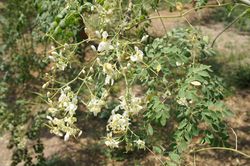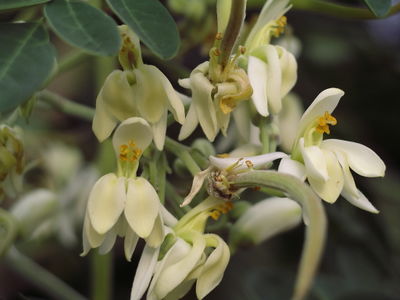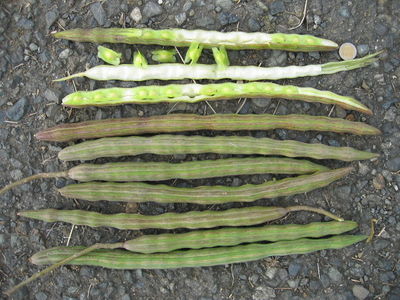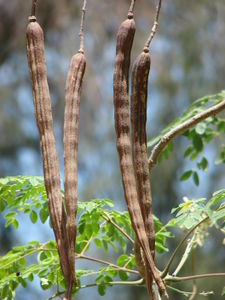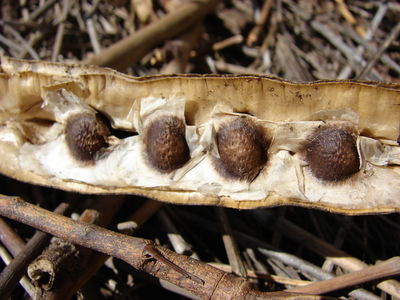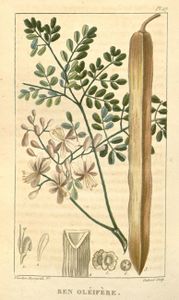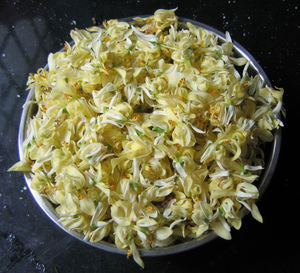Moringa oleifera
Moringa oleifera Lam.
| Ordre | Brassicales |
|---|---|
| Famille | Moringaceae |
| Genre | Moringa |
2n = 28
Origine : sud de l'Himalaya
cultivé
| Français | mouroungue (Mascareignes); néverdié (Afrique de l'Ouest) |
|---|---|
| Anglais | horseradish tree |
- feuilles consommées comme légume cru ou cuit
- poudre de feuilles riche en protéines
- fleurs consommées comme légume
- fruits consommés comme légume
- graines consommées grillées
- racine rapée substitut du raifort
- huile des graines utilisée comme huile de cuisson,
lubrifiant, en parfum ou pour faire du savon - médicinal
- fourrage : feuilles
- plante mellifère
- graines et tourteau comme floculant pour purifier l'eau
- gomme de l'écorce utilisée comme agent tannant
- bois de feu
- planté en haie vive, ornemental ou en culture en allées
Sommaire
Description
fruits verts (Crops for the Future)
Noms populaires
| français | mouroungue (îles Mascareignes) ; néverdié (Afrique de l'Ouest) ; ben ailé, raifort en arbre |
| créole antillais | maloko, moulen kilé (TRAMIL) |
| créole haïtien | benzoliv, ben olifère, bambou-bananier, graines benné (TRAMIL) |
| anglais | horseradish tree, drumstick tree, behen tree |
| espagnol | moringa, ben, paraíso |
| portugais | moringa, moringueiro |
| italien | moringa |
| swahili | mzunze, mronge, mlonge (PROTA) |
| hindi | saṁjhnā (saonjana); mungna, sainjna, shajna (Wealth of India) |
| bengali | sajina (Wealth of India) |
| marathi | achajhada, shevgi (Wealth of India) |
| gujerati | midhosaragavo, saragavo (Wealth of India) |
| telugu | mulaga, munaga (Wealth of India) |
| malayalam | moringa, murinna, sigru (Wealth of India) |
| tamoul | murungai (Wealth of India) |
| kannada | nugge (Wealth of India) |
| konkani | maxing |
| assam | saijna, sohjna (Wealth of India) |
| Orissa | sajina (Wealth of India) |
| Punjab | sainjna, soanjna (Wealth of India) |
| Santal | munga arak (Wealth of India) |
| Philippines | malunggay (tagalog) (PROSEA) |
| Indonésie | kelor, marunga (Timor) (PROSEA) |
| Malaysia | meringgai, gemunggai (PROSEA) |
| Thaïlande | marum (général), phakihum (nord-est), makhonkom (nord) (PROSEA) |
| Vietnam | chùm ngấy (PROSEA) |
| Laos | 'ii h'um (PROSEA) |
| Cambodge | mrum" (PROSEA) |
| Birmanie | dandalonbin (PROSEA) |
- Voir l'étymologie de Moringa et mouroungue
Classification
Moringa oleifera Lam. (1783)
synonymes:
- Guilandina moringa L. (1753)
- Moringa pterygosperma Gaertn. (1791)
Cultivars
Histoire
Originaire du nord-ouest de l'Inde, Moringa oleifera est cultivé depuis longtemps. Il porte plusieurs noms sanscrits, ṡigru, ṡobhānaka ou ṡobhāñjana, d'où vient le nom hindi saṁjhnā (saonjana). Les Européens l'ont souvent confondu avec le ben égyptien, dont l'huile était commercialisée en Europe au Moyen-Age. Les Portugais l'ont découvert à Goa, et l'ont appelé moxingo (du konkani maxing) ou plus souvent moringa (du malayalam moringa, murinna), à l'origine du nom scientifique. L'arbre a été introduit dans les Mascareignes par des Tamouls, d'où le nom de mouroungue, emprunté au tamoul murungai. Aujourd'hui, Moringa oleifera est largement cultivé en jardins familiaux en Asie, en Afrique tropicale et même dans les Antilles.
Les arbres ont souvent une vilaine allure, car ils sont constamment élagués pour l'usage des feuilles.
Usages
Cultivated in many subtropical and tropical countries in Africa, Asia and Central and South America, mostly as single trees. The glucosinolates-containg leaves, flowers and young fruits are used as vegetable, the taste resembling cress or other cruciferous crops; fruits and seeds are prepared to salads and curries and the roots are a horseradish-like spice. The species is an important medicinal plant, especially in Asia. As kind of a blessed tree it is applied in various religious and superstitious practises in tropical countries. More recently the coagulating ability of the seed powder became important for water purification in arid regions. Oil is prepared from the seeds, too and the species is planted also as living fence or as leaf forage plant. Selection of clones with annual short-stem growth of this multipurpose tree has been proposed. In India the cultivation of this species has a very long tradition, here and in other countries various local races had been evolved.
Alimentation
Fruits
- Appelés "drumsticks" (baguettes de tambour) ou "bâtons mouroungue". Les jeunes fruits sont consommés comme légume dans le sud de l'Asie.
Graines
- Graines consommées grillées, ou ajoutées aux sauces.
- Huile des graines utilisée comme huile de cuisson.
Feuilles
- Consommées crues en salade, ou cuites en soupes ou en sauces. A la Réunion, on les appelle "brède mouroungue" or "brède médaille".
- Poudre de feuilles promue en Afrique comme ingrédient riche en protéines.
Fleurs
- Consommées comme légume, en sauces ou en infusion.
Racines
- Racines rapées consommées comme un substitut de raifort.
Médecine
"Presque toutes les parties de la plante ont des applications en médecine traditionnelle. Les usages notamment comme calmant, vermifuge, antispasmodique et désinfectant (bactéricide, fongicide) sont répandus." (PROTA)
Fourrage
- Feuilles mangées par le bétail.
- Mellifère.
Usages techniques
- graines pilées et tourteau utilisés comme floculant pour purifier l'eau.
- huile des graines utilisée comme lubrifiant, pour les parfums, pour faire du savon.
- Gomme de l'écorce utilisée comme agent tannant.
- Bois de feu.
Environnement
- arbre cultivé comme haie vive, ornemental ou en culture en allées.
Références
- Bekele-Tesemma, Azene, 2007. Useful trees and shrubs for Ethiopia. Identification, propagation and management for 17 agroclimatic zones. Nairobi, ICRAF - RELMA. 550 p. (Technical Manual 6). Voir l'article
- Bennett, R.N., Mellon, F.A., Foidl, N., Pratt, J.H., Dupont, M.S., Perkins, L. & Kroon, P.A., 2003. Profiling glucosinolates and phenolics in vegetative and reproductive tissues of the multi-purpose trees Moringa oleifera L. (Horseradish tree) and Moringa stenopetala L. Journal of Agricultural and Food Chemistry, 51(12): 3546–3553.
- Burkill, H.M., 1997. The useful plants of West Tropical Africa. 2nd Edition. Volume 4, Families M–R. Royal Botanic Gardens, Kew, Richmond, United Kingdom. 969 p.
- Chauvet, Michel, 2018. Encyclopédie des plantes alimentaires. Paris, Belin. 880 p. (p. 470)
- Elevitch, Craig (ed.), 2011. Specialty Crops for Pacific Islands: horticulture, value-added processing, and marketing. Holualoa, Hawai'i, Permanent Agriculture Resources. 576 p., 940 photos. Agroforestry télécharger le pdf
- Eyog Matig, O., Ndoye, O., Kengue, J. et Awono, A. (eds), 2006. Les Fruitiers Forestiers Comestibles du Cameroun. Rome, IPGRI, CIFOR, IRAD. XIV-204 p. Voir l'article
- Jahn, S.A.A., 1986. Proper use of African natural coagulants for rural water supplies: Research in the Sudan and a guide for new projects. GTZ, Eschborn, Germany. 541 p.
- Jahn, S.A.A., Musnad, H.A. & Burgstaller, H., 1986. The tree that purifies water: cultivating multipurpose Moringaceae in the Sudan. Unasylva 152: 23–28.
- Lost Crops of Africa. Volume II: Vegetables, 2006. Washington, National Academies Press. 354 p. en ligne
- Polprasid, P., 1993. Moringa oleifera Lamk. In: Siemonsma, J.S. & Kasem Piluek (Editors). Plant Resources of South-East Asia No 8. Vegetables. Pudoc Scientific Publishers, Wageningen, Netherlands. pp. 213–215.
- Ramachandran, C., Peter, K.V. & Gopalakrishnan, P.K., 1980. Drumstick (Moringa oleifera): a multipurpose Indian vegetable. Economic Botany, 34: 276–283.
- Rollet, Bernard et coll., 2010. Arbres des Petites Antilles. Tome 1 : Introduction à la dendrologie. 276 p. Tome 2 : Description des espèces. 866 p. + 46 pl. coul. + CD de photos sur l'anatomie du bois. Basse-Terre, ONF. Voir sur Pl@ntUse.
- Saint-Sauveur, Armelle de, 1993. Le moringa, un arbre à multiples usages pour le Sahel. In: Riedacker, A., Dreyer, E., Pafadnam, C., Joly, H. & Bory, G. (Editors). Physiologie des arbres et arbustes en zones arides et semi-arides. Séminaire Paris-Nancy, 20 mars–6 avril 1990. Libbey, Paris, France. pp. 441–446.
- TRAMIL, Pharmacopée végétale caribéenne, éd. scient. L. Germosén-Robineau. 2014. 3e éd. Santo Domingo, Canopé de Guadeloupe. 420 p. Voir sur Pl@ntUse
- Wealth of India (The), 1962. A dictionary of Indian raw materials and industrial products. Raw materials. Volume 6: L–M. Council of Scientific and Industrial Research, New Delhi, India. pp. 426-429.
Liens
- Agroforestry
- BD des Plantes d'Afrique
- BHL
- ECHO Technical notes téléchargeables en pdf: Moringa tree, Moringa recipes et Moringa leaf powder
- Ecoport
- Feedipedia
- Flora of Pakistan
- FAO: L'arbre qui purifie l'eau
- GRIN
- IPNI
- Mansfeld
- Metafro
- MoringaNews
- New Crops Purdue
- page de Mark Olson au Mobot
- PROSEA sur Pl@ntUse
- PROTA sur Pl@ntUse
- SEPASAL (lien brisé à corriger)
- article de Sturtevant
- page de John Sutherland
- TAXREF
- Tela Botanica
- Useful Tropical Plants Database
- Plus de photos sur Wikimedia Commons
- Wikipedia
- Wikiphyto
